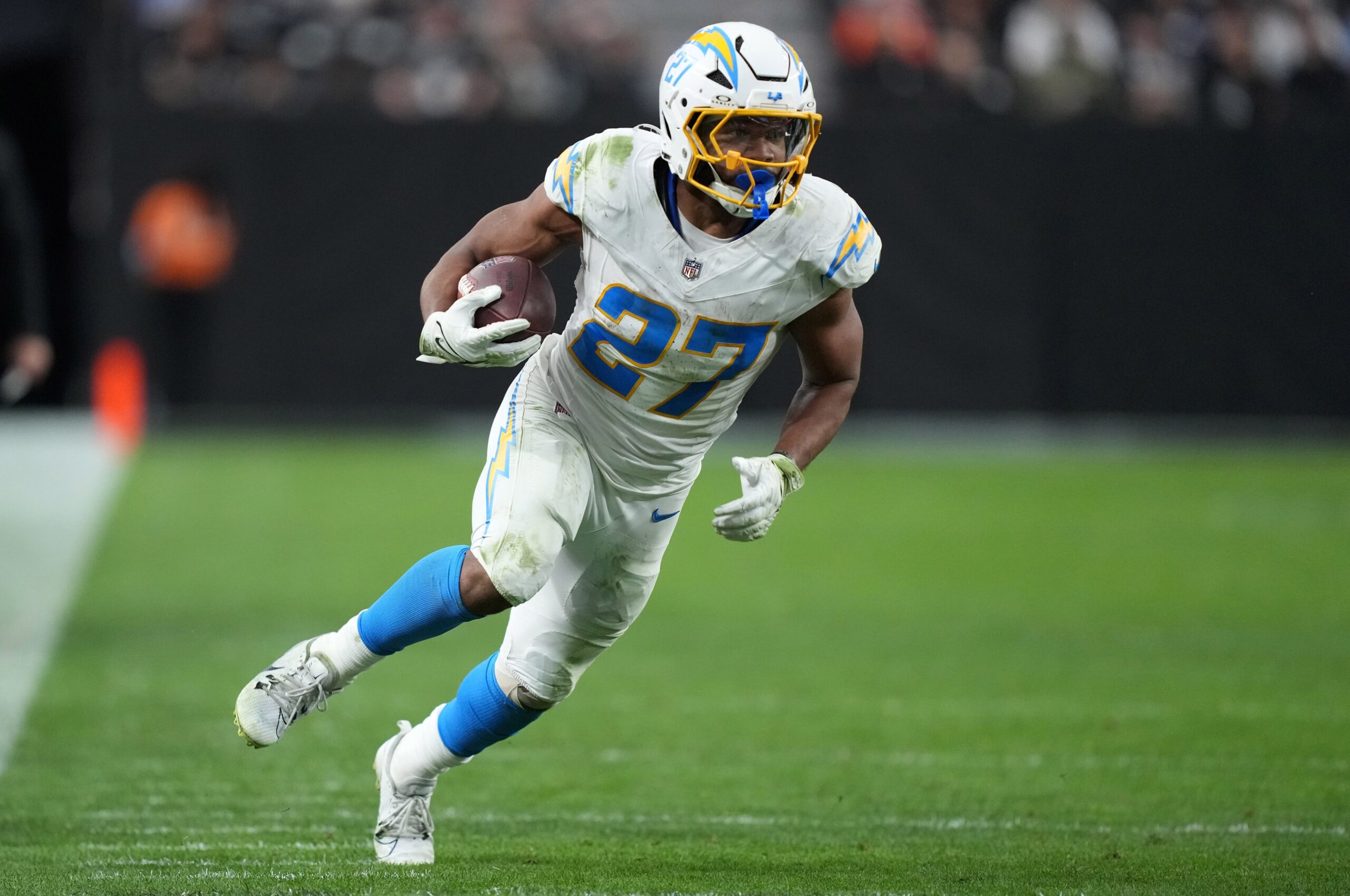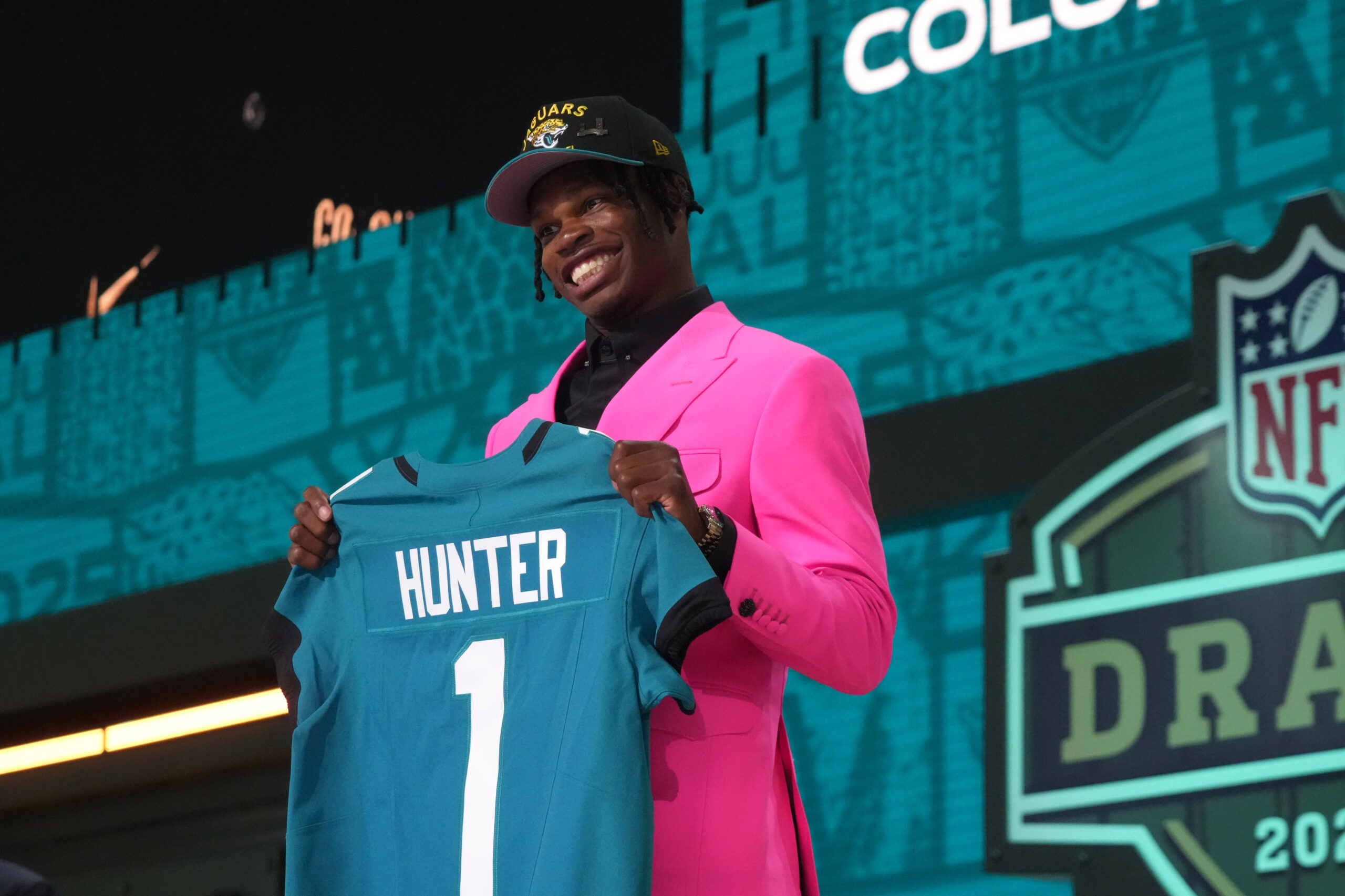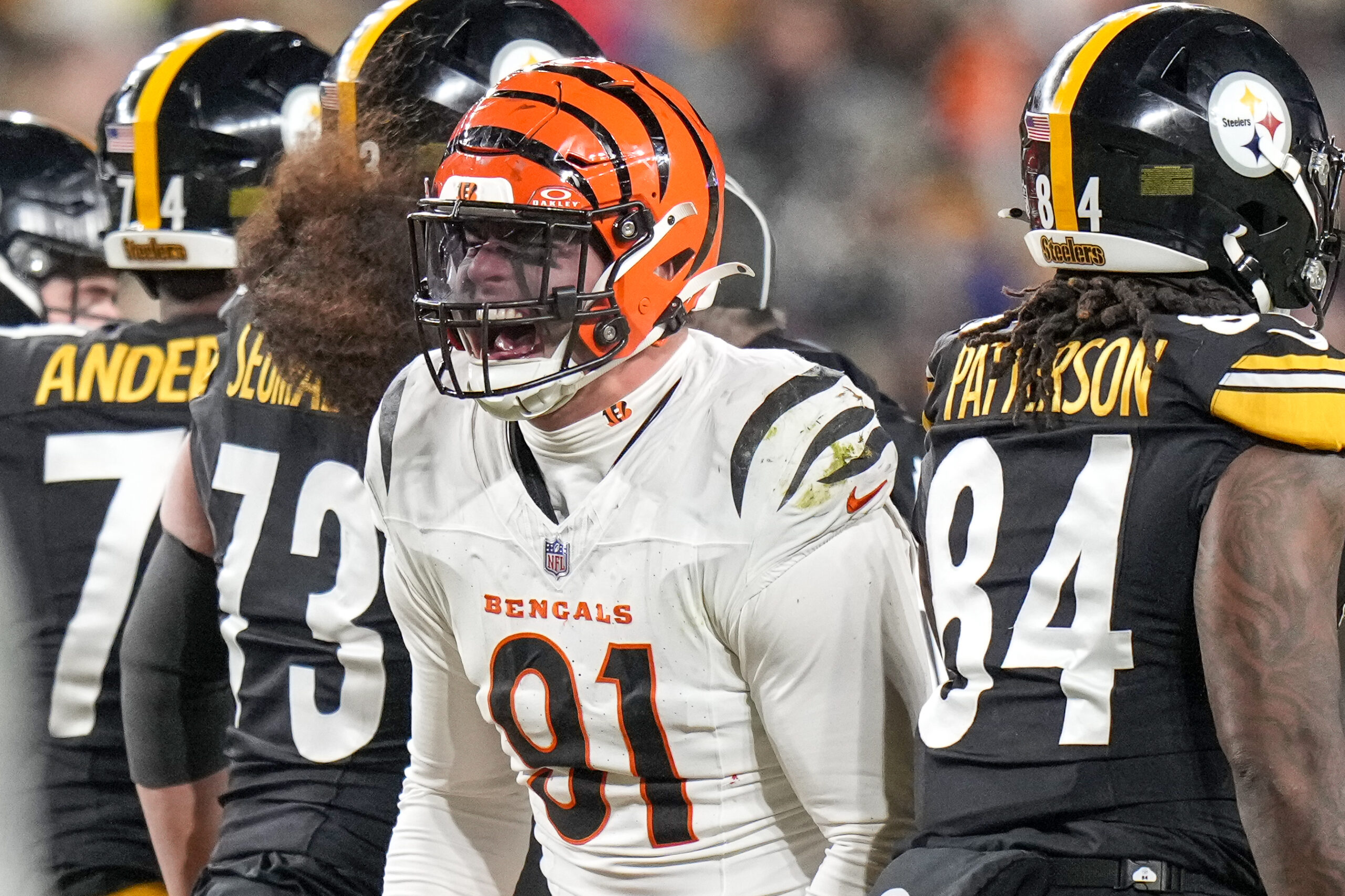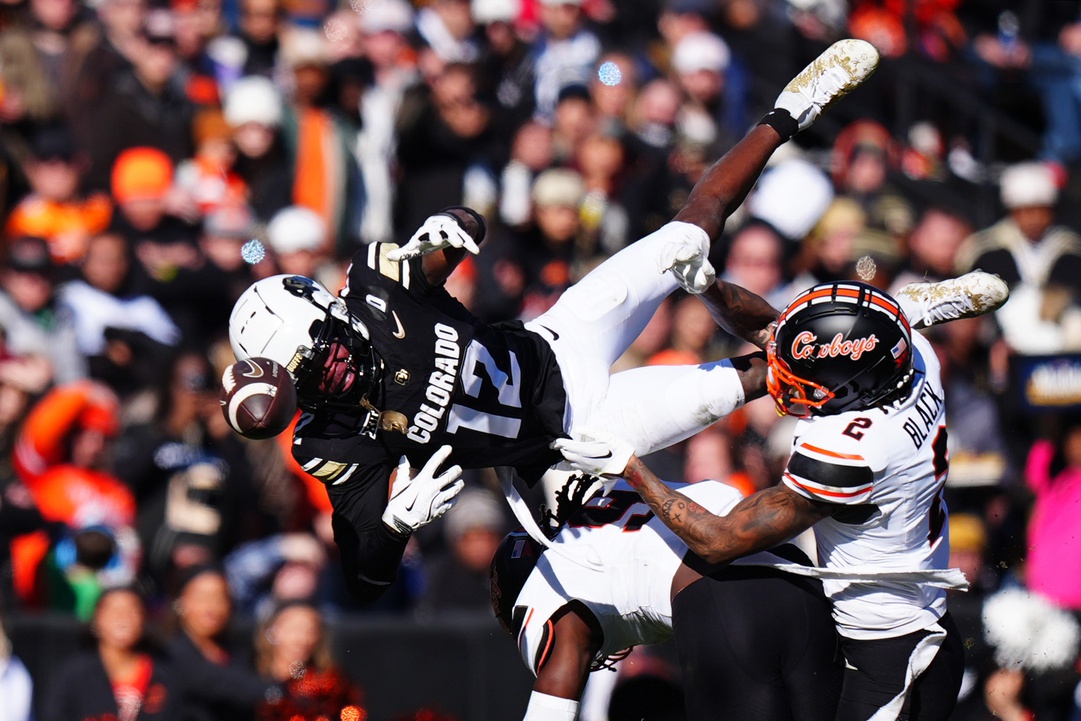NFL Analysis
12/30/24
23 min read
1st & 10 Week 17: Vikings Playing For A Bye, Bengals Still Alive, Jayden Daniels Comes Through Again

Just a few years ago, the NFL regular season would have been over by now. We still have a week left, but Week 17 — as long as it was — gave us a pretty good peek into what the playoffs will look like. Seeding is still up in the air but just two playoff spots remain open.
Each week, 1st & 10 will bring you a Monday morning in-depth breakdown of everything you need to know from Sunday’s slate of games. We’ll fill this column with stats, film, and plenty of words to keep you covered on anything you might have missed or want to dive deeper into from Sunday.
All stats provided by TruMedia unless noted otherwise
1st & 10 NFL Week 17
1. The Vikings Have A Shot At The No. 1 Seed
The Week 18 Sunday Night Football matchup will feature Sam Darnold and Jared Goff throwing for the No. 1 seed in the NFC. That’s what we all expected at the start of this season, right?
Minnesota’s 27-25 victory against the Green Bay Packers set the stakes for the regular season finale, regardless of Detroit’s game Monday night against San Francisco.
The Vikings were aggressive on both sides of the ball throughout the game, and that strategy paid off.
On Green Bay’s first drive of the game, Jerry Tillery forced a fumble on a Josh Jacobs run, which was recovered by Cam Bynum.
We’ve seen many players added, like Andrew Van Ginkel and Jonathan Greenard, who were signed specifically to fit in this type of defense, but getting solid snaps from a player like Tillery, a former first-round pick on his third team, really highlights how much this defense gets the most out of its players.
With that turnover, the Vikings have forced a turnover in every game this season. They are the 20th team since 2000 to force a turnover in 16 straight games during the regular season. If they do it next week, they will be the first team to do so in 17 straight regular season games. The last team to go a full season was the 2020 Miami Dolphins, the year before the 17-game schedule started.
It wasn’t just the turnovers or splash plays. The Vikings held the Packers by making things as difficult as possible on a down-to-down basis. Minnesota played man coverage on 47.1 percent of Jordan Love’s dropbacks, according to Next Gen Stats, its second-highest rate of the season. That included an 84.6 percent rate on third and fourth down.
The Vikings allowed 4.1 yards per attempt when playing man, compared to 8.2 yards per attempt when playing zone. Love was just 3-of-7 for 14 yards against man coverage in the first half.
Those first half looks really screwed with Love, who looked uncomfortable picking spots from the pocket. Despite only being pressured on 15.3 percent of his dropbacks in the first half, Love was inaccurate on a third of his passes because of the tight windows Minnesota created in coverage. It led to Love forcing balls and missing his targets.
This is a way to pick at the Green Bay offense, especially with the team’s deep threat, Christian Watson, out for the game. The Packers have a fun, deep group of wide receivers but not a group full of man-beaters. If a defense feels comfortable playing man, that’s a way to go. Coming into this week, Love ranked 27th in EPA per play against man coverage (-0.08) and fourth (0.20) against zone.
In the second half, the Vikings were more aggressive with blitzes, but Love was more prepared. But when the pressure came in the second half, it was successful.

It was only 13-3 at halftime, but the Vikings felt in control for the entire time. Darnold had his most passing yards in a game this season — and his career — while he averaged 0.29 EPA per play and a 57.1 percent success rate.
The Vikings didn’t get much going on the ground, so it was up to the passing game, which spread the ball around early. Green Bay focused coverage on Justin Jefferson, and Minnesota used that to its advantage.
On the touchdown to Jalen Nailor, Jefferson held the attention of the safety to the left while the deep safety had to account for the threat of Jordan Addison to go deep. That left Nailor uncovered once he got past the second level of defenders.
That was also off of a no-huddle play. The Vikings ran no-huddle on 14.9 percent of their plays, their second-highest rate of the season, and Darnold went 7-of-7 for 106 yards and a touchdown for 1.26 EPA per play.
Later in the game, Darnold hit Addison on a touchdown off a hitch-and-go. The Vikings lined up Addison and Jefferson to the right side of the formation. Jefferson lined up outside and ran a dig over the top. That pulled the corner toward the middle of the field and left an open throw to Addison off the double move.
— Dan's Clips (@dansfilmclips) December 30, 2024
In the second half, the Vikings found a way to get Jefferson involved with more than just his gravity.

Since the run game wasn’t working as well — the Vikings had a 34 percent rushing success rate — Jefferson became the closer that a run game might have been otherwise.
This was the case even when there were small windows to hit.
That led to more confidence in the passing offense to close out the game. After getting the ball back following a Green Bay touchdown that brought the Packers within two points, the Vikings opened the drive with a 13-yard pass to FB C.J. Ham to run the clock and get to the two-minute warning.
Then, on third-and-2 to ice the game, Minnesota threw to Cam Akers to clinch the win.
Now, the Vikings will go into Detroit with a chance to win the NFC North and claim the top seed in the conference. The winner gets a bye, while the loser will drop to the No. 5 seed.
This is an incredible feat for Kevin O’Connell. The offense has a wide margin for error but often makes the most of its opportunities. The defense is an aggressive chaos-creator. Bye or not, the Vikings are one of the best teams in the league and a contender in the NFC.
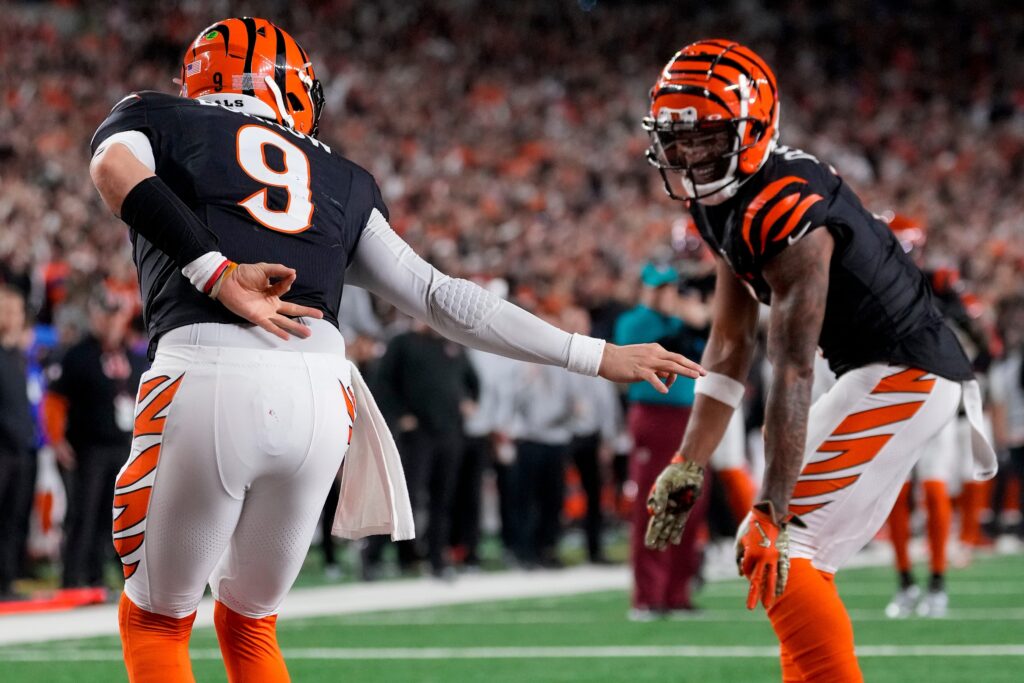
2. Cincinnati Won an overtime thriller
The standout game of the extended section of this weekend's slate of games was the Saturday afternoon matchup between the Cincinnati Bengals and Denver Broncos. The Bengals and the Broncos were vying for the final wild-card spot in the AFC, and the Broncos would have been in with a win. But Cincinnati prevailed with a 30-24 overtime victory.
Cincinnati’s offense, behind Joe Burrow, overcame a defense that struggled to stop Denver from moving down the field.
With Patrick Surtain on Ja’Marr Chase, the Bengals went elsewhere in the passing game. Early on, that meant spamming passes to tight ends and challenging the flats while clearing that space with vertical routes. Burrow threw 30.8 percent of his targets to out routes, which put a ton of stress on whoever was in outside coverage for the Broncos. In the first half, 45 percent of his targets went to tight ends.
As the Broncos tried to clamp down on those throws, it eventually opened up more for Tee Higgins against Riley Moss. In the second half, Higgins had four catches for 47 yards and a touchdown. Then, he had four catches for 59 yards and a touchdown in overtime.
Higgins’s dominance highlighted how important he is to the ceiling of the Cincinnati offense. With Surtain on Chase for 43 of his 56 routes, per Next Gen Stats, the Bengals had another No. 1-caliber wide receiver to target in high-leverage situations. Of course, Chase also had more than 100 receiving yards but did most of his work on his snaps not lined up across from Surtain.
The touchdown to Higgins in the fourth quarter was a perfectly placed ball in the back corner of the end zone that Higgins high-pointed over Moss.
Higgins might have the strongest hands in the league, and he’s become a dominant contested-catch receiver because of his size and strength.
He also has the smoothness and quickness to win in the short area, like he did on the game-winner in overtime.
This game took some twists and turns to get to overtime.
After Bo Nix spent much of the game dinking and dunking on checkdowns with an average depth of target of 1.9 and an average depth of completion of 0.8 through the first half, he ripped an insane deep ball that traveled 64 yards in the air in the third quarter. He then followed it up with an insane 25-yard touchdown on the run on a fourth-and-1 with 14 seconds remaining to tie the game.
There was some debate about going for two after the touchdown to win, but given that the Broncos could have clinched a playoff spot with a tie, the argument for kicking it is fine.
Denver was only in that spot because Cincinnati’s attempt to ice the game failed. On the previous drive, Chase Brown had a five-yard run from the 6-yard line, but he slid to go down short of the goal line. He did that awkwardly and ended up with what was reported as a high ankle sprain. Instead of keeping the clock moving, the Bengals were forced to use a timeout, and the Broncos got to save their final timeout.
Cincinnati scored on the play after the timeout and gave the ball back to Denver. The Broncos drove down the field and got to use their saved timeout right before the fourth-and-1 attempt.
The Bengals and Broncos traded punts to start overtime. On Cincinnati’s second overtime drive, Denver used two timeouts to stop the clock, despite it benefitting the Broncos if the clock expired. The Bengals hit the upright on a 33-yard field goal attempt, and then the Broncos went three plays and two yards in 23 seconds, including an incompletion on third-and-8 that stopped the clock.
Denver would have clinched a playoff spot had the Broncos run out the final 2:43, but they punted the ball back to the Bengals, who went 63 yards in five plays for the touchdown.
The Broncos are still in with a win against the Chiefs backups next week. But if they lose, it opens it up for the Dolphins and Bengals. Miami gets in with a win and a Denver loss, while Cincinnati gets in with a win if both of those teams lose.

3. More Late-Game Jayden Daniels
It was the Jayden Daniels show again. Washington needed overtime to get past Atlanta, 30-24, and the win locked in the Commanders for a spot in the playoffs.
Early on in this game, the Atlanta defense was having its way with Washington by manipulating the line with simulated pressures — we mentioned how the Falcons had upped their sack rate post-bye with this strategy.
Atlanta would load the line and show a blitz but only rush four with an unexpected second-level defender still coming on the rush. The Falcons got a sack on this early in the game and got Daniels to throw an interception on it afterward.
Daniels was sacked five times, but when the Commanders needed something to happen, they went with the quarterback’s legs. He had a career-high 127 rushing yards on 16 carries with seven carries and 72 yards on scrambles.
This season, Daniels has been dangerous as a scrambler, putting up a 69.9 percent success rate and 0.71 EPA per play. Scramble success can be tricky because the failed attempts are typically sacks, and those don’t get counted against the EPA and success rates, but Daniels so rarely takes sacks when he decides to run.
What’s made Daniels even more threatening as a runner is how comfortable he’s become throwing on the run.
This was an issue in college and early in the season, but now Daniels is often keeping his eyes up and looking for something to open up down the field.
Daniels was 5-of-6 for 87 yards and a touchdown outside the pocket. Even with three sacks out of the pocket, he had 0.76 EPA per play when he left the tackle box.
Washington leaned into the run game in the second half and dared Atlanta defenders to tackle. The Commanders had a huge play advantage — it ended up being 77 to 60 — and the Falcons looked gassed late in the game on defense.
Despite A.J. Terrell shutting down Terry McLaurin (Terrell lined up from McLaurin on 32 of 34 routes and allowed one catch for five yards on six targets while playing press 43 percent of the time, per Next Gen Stats), the Falcons didn’t have an answer on the ground — the Commanders had a 70.6 percent rushing success rate in the second half.
The Falcons were the only other team this season to have at least 20 rushing attempts and a 70 percent success rate in a half, which came in Week 6 against the Panthers. Atlanta had a 76.5 percent success rate on the ground on 17 carries in the first half against Washington but moved away from it in the second half with a 79.2 percent pass rate.
Atlanta sent the game to overtime on a rocket throw from Michael Penix to Kyle Pitts on fourth and goal, but the Falcons never touched the ball in overtime.
Daniels kept the ball moving with his legs…
…and then found Zach Ertz for the game-winner.
Daniels is tied for third in EPA per play among quarterbacks in the fourth quarter this season (0.36), and he's third (0.39) in the fourth quarter while trailing or tied. He's tied with Lamar Jackson and Joe Burrow for most passing touchdowns (eight) in that scenario. He's tied with Burrow overall with nine touchdowns, adding a rushing score for each.
Washington has an offense that can put up points in many ways, and as long as the quarterback is healthy, there’s a path to a productive offense.
Atlanta now needs a win against Carolina and a Tampa Bay loss to New Orleans to win the NFC South.
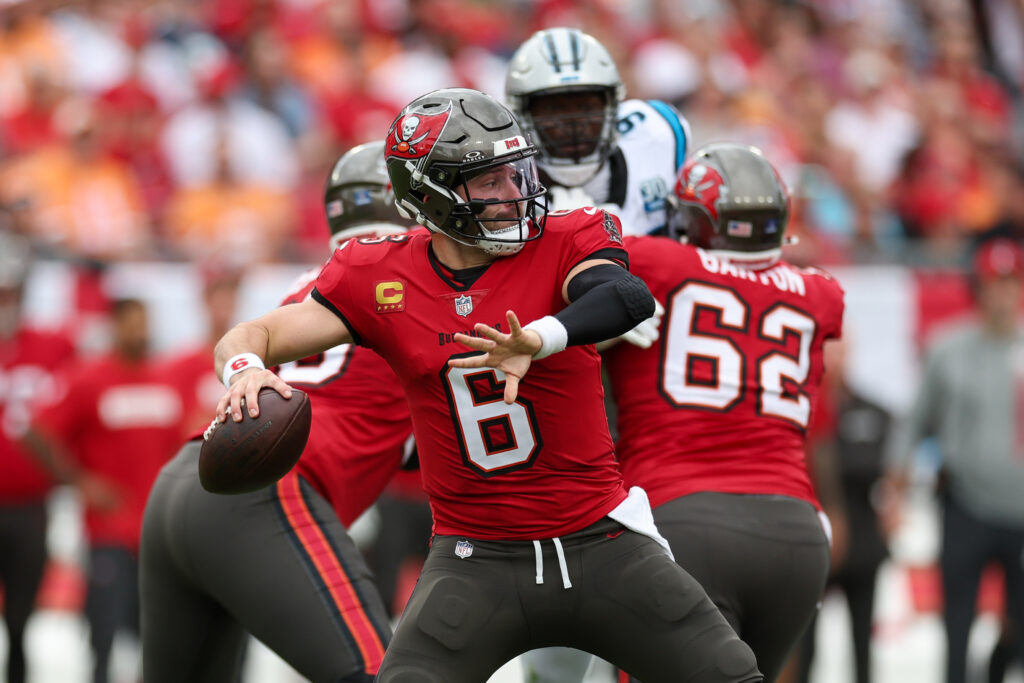
4. Tampa Bay's offense keeps going off
It was another great day for Baker Mayfield and the Tampa Bay Buccaneers passing offense. The Buccaneers had a 48-14 win over the Carolina Panthers and put themselves in position to win the NFC South with a win against the New Orleans Saints in Week 18.
The win started off fast, as most Buccaneers games have this season. Tampa Bay has scored a touchdown on eight of its 16 opening drives this season, tied with the Buffalo Bills for the highest rate in the league. Tampa Bay has a league-leading 1.67 EPA per drive and 3.88 points per drive on opening possessions in 2024.
Tampa’s first drive ended with a touchdown throw to Mike Evans.
Evans ended the game with 97 yards and two touchdowns on seven catches. He’s now 85 yards shy of his 11th-straight 1,000-yard receiving season.
Mayfield finished with 0.66 EPA per play and a 62.9 percent success rate, both his highest marks of the season. The Buccaneers keep pulling the right levers for this offense. Mayfield used a season-high 31.4 percent play-action rate, and he went 10-of-11 for 166 yards on those attempts.
It’s helped that the Buccaneers have leaned into some heavier personnel groupings of late and have found success while mixing things up. A few weeks ago, they leaned into more tight ends, and this week, they had a season-high 10.8 percent of plays in 21 personnel, where they averaged 0.95 EPA per play.
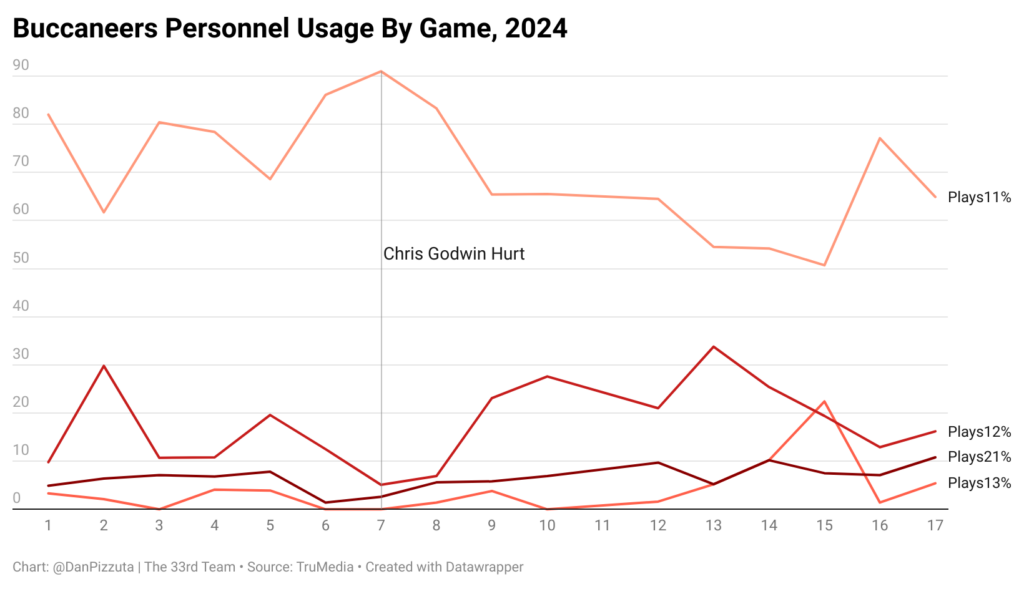
Bucky Irving’s 34-yard run came with Rashaad White also on the field, running jet motion to freeze the defense.
Then, Jalen McMillan’s 10-yard touchdown came from 21 personnel. White was offset in the backfield as Irving motioned out. Mayfield faked a screen to Irvin, and McMillan sold a block at the top of the screen, which left the corner flatfooted.
Defensively, the Buccaneers blitzed the Panthers on 42.9 percent of plays, including 75 percent of third downs. They pressured Bryce Young on 50 percent of his dropbacks.
With a good offense and a chaotic defense, the Buccaneers could be a tough opponent for a wild-card team should Tampa Bay win the NFC South. That would put them against the No. 5 seed, which would be either the Lions or Vikings. The Bucs beat the Lions 20-16 in Week 2.
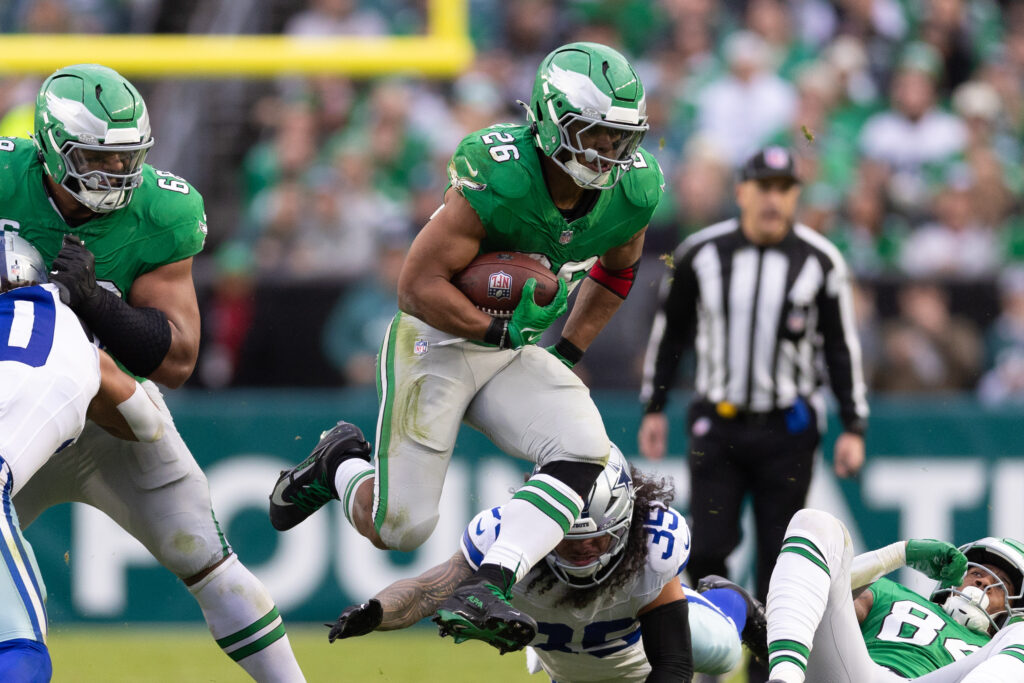
5. Saquon Barkley, Eagles clinch NFC East
Saquon Barkley has 2,005 rushing yards on the season. He’s the first back since Derrick Henry in 2020 to hit that mark, and he’s now 100 yards shy of tying Eric Dickerson’s single-season rushing record.
Barkley has been the league’s most valuable back, leading all running backs in EPA on rushing attempts. He also has that lead among the group of backs who have rushed for at least 2,000 yards since 2000.
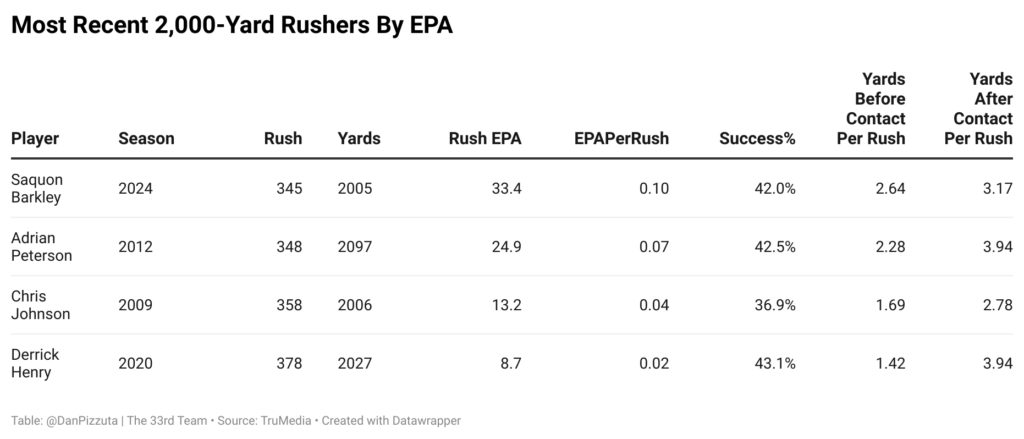
While he has those solid blocking numbers in front of him, Barkley hasn’t only been taking advantage of running behind a good offensive line. Per Next Gen Stats, Barkley has averaged a league-high 1.62 yards above expectation per carry this season. That would be the highest for a back with at least 200 carries on the season.
The only two backs with at least 100 carries to top that figure are De’Von Achane last season with 2.87 on 103 carries and Rashad Penny with 1.86 on 119 carries in 2021.
With the Eagles locking up the NFC East and the No. 2 seed, there’s nothing for them to play for in Week 18, so it’s unclear if the Eagles will dress Barkley or any other starters against the Giants in an attempt to break the record.
Deciding to do so would be a full team effort because trying to break the record against Barkley’s former team would need the full offensive line and credible receiving threats.
Whether the Eagles take a swing at the record or not, this has been an incredible season for Barkley, potentially capped by his 167-yard performance against the Cowboys in a 40-7 win.
Kenny Pickett started at quarterback, and while he had some nice throws — as did Tanner McKee with his two touchdowns in four attempts after Pickett left the game — the Cowboys did not respect the threat of the pass. Barkley rushed into a stacked box of eight or more defenders on 48.4 percent of his attempts. Barkley, Henry, and Najee Harris are tied with 10 games of at least 10 rushes and 40 percent of those into a stacked box this season.
This wasn’t Barkley’s most efficient game of the season, but it highlighted his ability to find the holes and avoid negative plays behind this offensive line. Barkley averaged 2.9 yards before contract per rush against Dallas and was stuffed on just 12.9 percent of his attempts.

6. Giants won a game they should lose, Colts lost a game they should win
With a loss, the New York Giants would be in pole position for the first overall pick in the 2025 NFL Draft. With a win, the Indianapolis Colts would be the first team in position to make the playoffs with a win and a Broncos loss next week.
Naturally, the Giants won 45-33, a worst-case scenario for both teams.
This was a wild game that turned into a shootout between Drew Lock and Joe Flacco. Of course, it did. Lock had an unbelievable day. He finished with 1.18 EPA per play, going 17-of-23 for 309 yards (13.4 yards per attempt) and four touchdowns, with a rushing touchdown, too. Lock’s previous career-high in EPA per play was 0.64 during his rookie season.
Ironically, this game highlighted what the Giants could look forward to with a new quarterback, thanks to Malik Nabers's complete takeover. Nabers had 171 yards and two touchdowns on seven catches.
The first touchdown came on a third-and-14 screen that Nabers took 31 yards.
In the second quarter, Nabers adjusted to a deep underthrown pass for 34 yards that eventually set up a Wan’Dale Robinson touchdown.
Then, in the fourth quarter, Nabers took another short pass 59 yards for a touchdown.
This all came despite the Giants having a 16 percent success rate on running back attempts.
The Giants entered the week favored to finish with the first overall pick and now sit fourth, which is where they would stay should all the teams ahead of them also lose next week.
Indianapolis is now eliminated from the playoffs, ending a frustrating and inconsistent season — yet one that would have put them in the driver’s seat for a playoff spot if Jonathan Taylor crossed the goal line with the ball against the Broncos.

7. Dolphins stay alive
With Tua Tagovailoa out, Tyler Huntley helped lead the Miami Dolphins to a 20-3 win against the Browns. Tagovailoa was ruled out with a hip injury, and his status for Week 18 is still in question, though Mike McDaniel said surgery is not needed.
The win kept Miami alive for the final AFC playoff spot. If the Broncos lose to the Chiefs and the Dolphins beat the Jets — Aaron Rodgers just averaged a career-worst -1.03 EPA per play against the Bills — then Miami would get in as the seventh seed.
Huntley looked more comfortable in the offense than he did during his first stint filling in for Tagovailoa — he joked afterward that he knew what all the motions were this time — and that could be important if Huntley has to start another game this season.
Even without Jaylen Waddle, Huntley averaged 0.17 EPA per play and adjusted better to Miami’s quick passing game and middle-of-the-field targets.

Huntley also used his legs more, leading the team with 52 yards and a touchdown. However, that still raises some concerns about the Dolphins’ traditional run game, which has been a problem all season.
Miami had a 21.1 percent success rate and 1.7 yards per carry on running back attempts against Cleveland.
8. Chart of the day
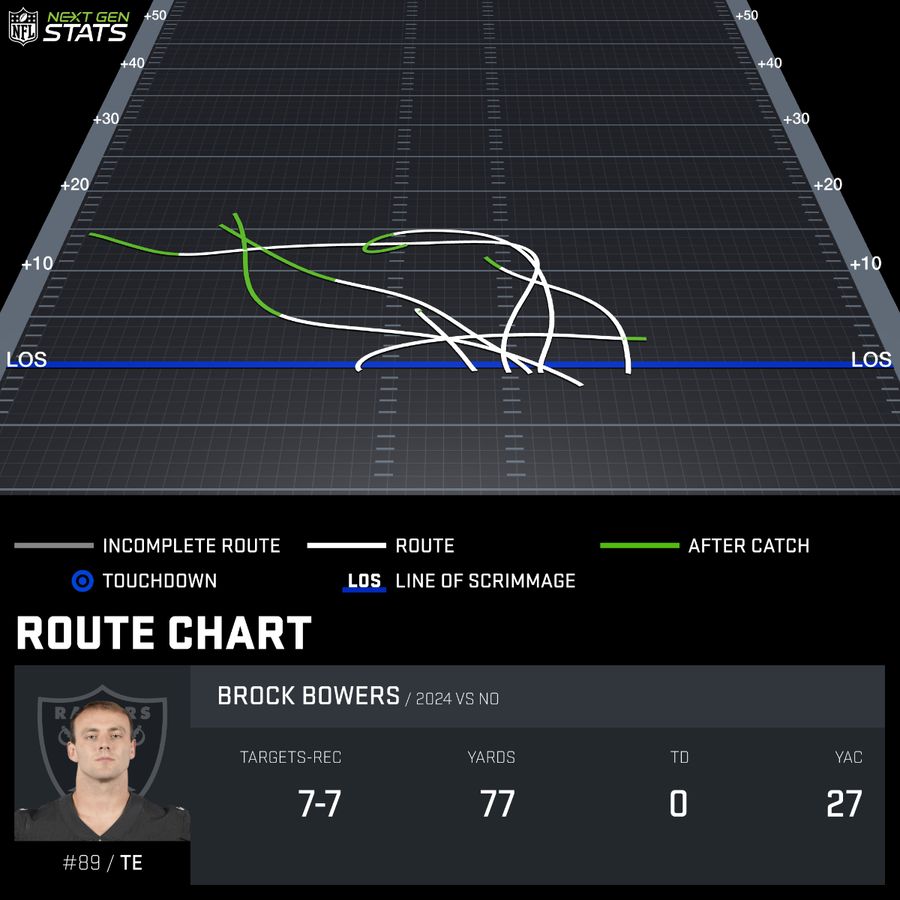
With seven catches and 77 yards, Brock Bowers set the record for receiving yards by a tight end and most receptions in a rookie season. He now has 108 catches for 1,144 yards this season with a week left to go.
He, along with Malik Nabers, joins Puka Nacua and Justin Jefferson as rookies with at least 500 routes to average at least 2.0 yards per route run with at least a 25 percent target share.
9. Play(s) of the day(s)
In Four Ups, Four Downs this week, we noted the ways the Chargers have gotten big plays from Ladd McConkey. One way had been from crossers.
In the 40-7 win against the Patriots, the Chargers sent McConkey on a return from a crosser stem that got him open in the back of the end zone. Watch as he sells the crosser, then cuts it back.
— Dan's Clips (@dansfilmclips) December 30, 2024
Later in the game, the Chargers sent McConkey vertical from the slot out of pistol, which resulted in a 40-yard touchdown.
— Dan's Clips (@dansfilmclips) December 30, 2024
Justin Herbert had his best of the season with 0.42 EPA per play, and the Chargers’ passing offense has looked as if it has figured some things out in the past few weeks.
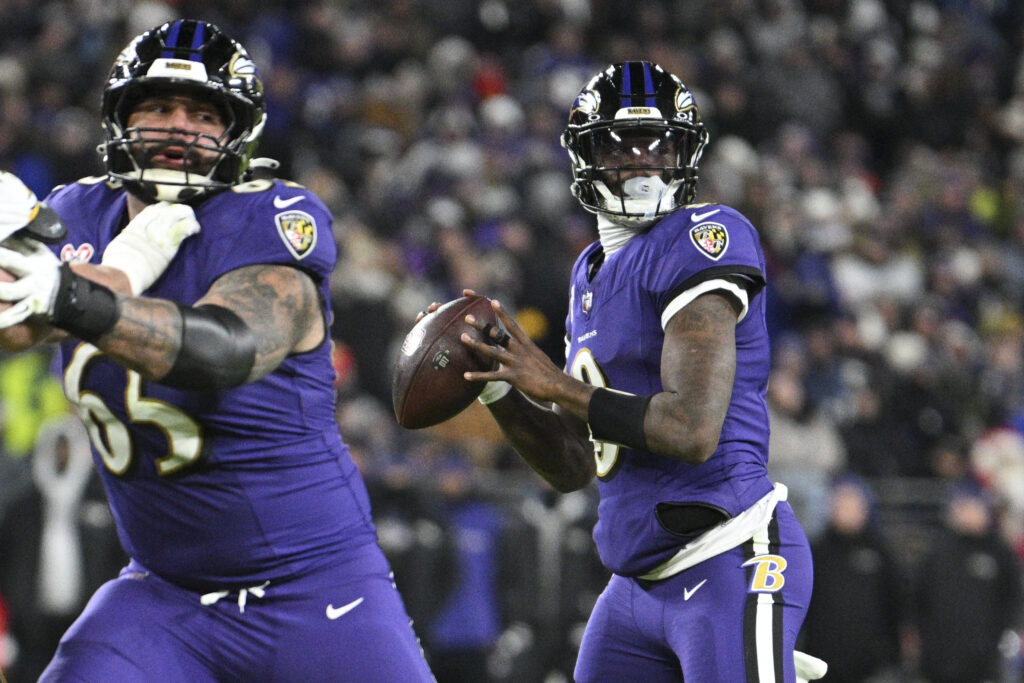
10. Where Does The MVP Race Stand?
With a 40-14 Buffalo Bills win against the New York Jets and the No. 2 seed locked up, we might have seen the last of Josh Allen for the regular season. That would end his presentation for his MVP case.
Allen finished with 0.31 EPA per play and a 50 percent success rate against the Jets in a game that was never in question.
Back on Christmas Day, Lamar Jackson averaged 0.74 EPA per play and a 60 percent success rate against the Texans in a blowout win. Jackson will still need to play in Week 18 with a win on Saturday afternoon, clinching the AFC North for the Ravens.
Before we head into the final week, let’s look at where these quarterbacks stand: Jackson currently has a slight lead in EPA per play (0.30 to 0.26), and he’ll get one more game in front of a national audience.
Looking at a three-game rolling average, Jackson had the lead for most of the season before Allen surged into December, but Jackson retook the lead with his recent hot stretch.

Looking at the cumulative EPA per play, Allen had the early lead thanks to big opening weeks, but Jackson has been on top since mid-October.
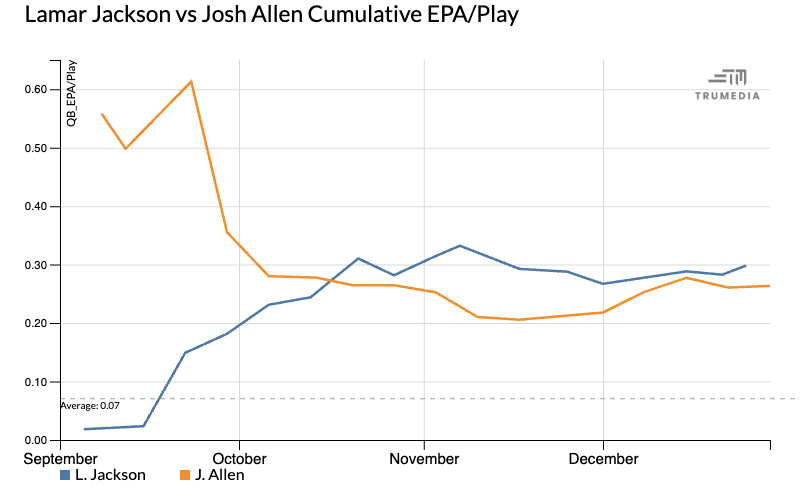
This is as close and deserving of a race as we’ve seen between two quarterbacks. There’s no wrong answer.
As much as this should be a regular season award that accounts for everything, the final results could be heavily weighted on Jackson’s final game — good or bad — because it will potentially be for the division on an island game without Allen having another game to make a statement.


